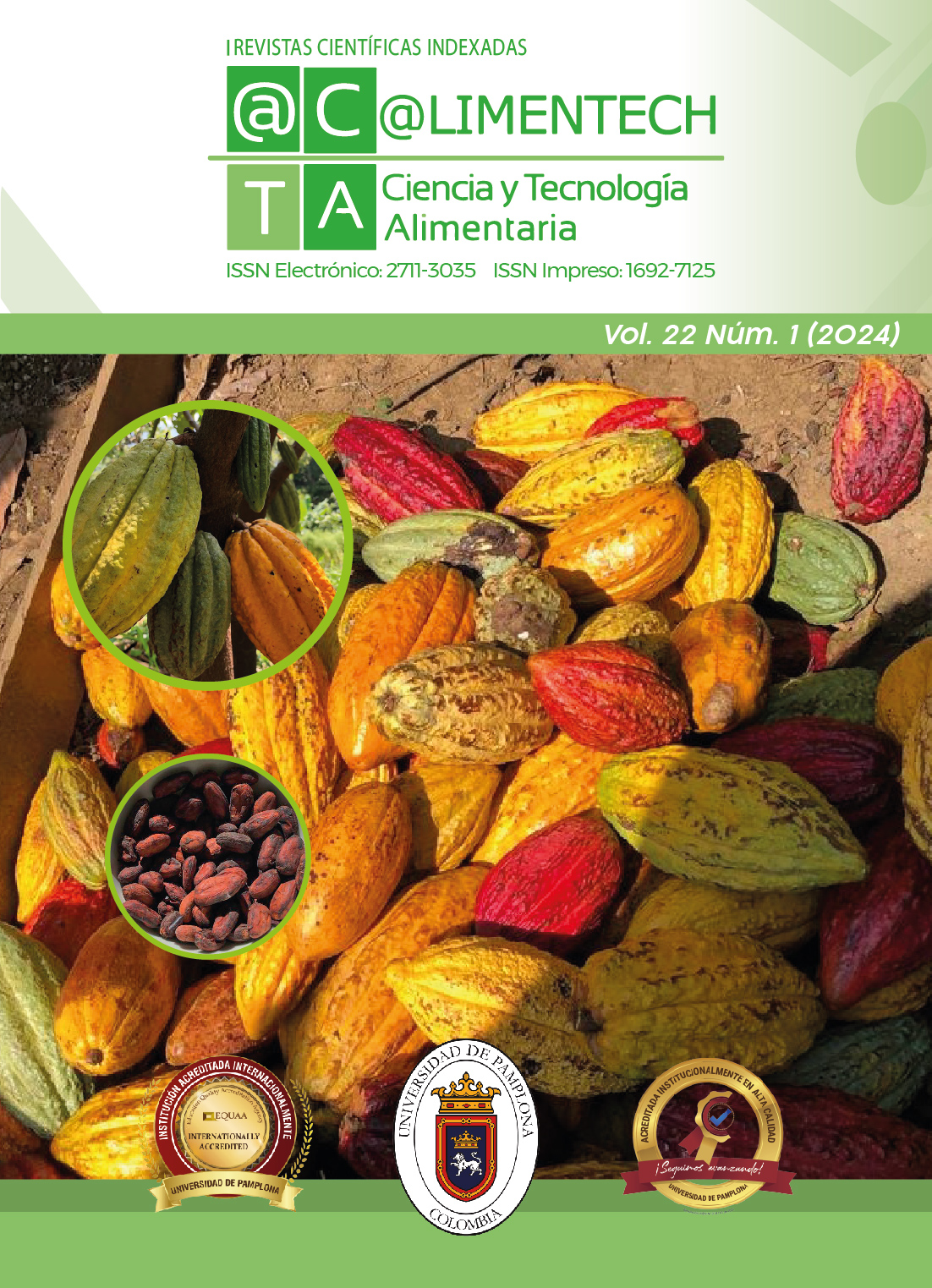FATTY ACID CONTENT IN SANTANDEREANA GOAT MEAT ACCORDING TO AGE AT SLAUGHTER
DOI:
https://doi.org/10.24054/limentech.v22i1.2862Keywords:
unsaturated acids, meat quality, goat meat, meat composition, polyunsaturated fats, saturated fatsAbstract
The Santander goat is recognized and accepted as a pure breed and Colombian genetic heritage. It is production system is based on free grazing. The physicochemical and nutritional composition of it is meat is very little know. Therefore, the objective of this study was to determine the total fatty acids content in Santander goat meat according to the age at slaughter. For this purpose, Longissimus dorsi, Bicep femoris and Bicep brachi muscles of the left half carcass were obtained from 9 carcasses of 4, 8 and 14 months of age. The muscles were vacuum packed and stored refrigerated  for 12 hours until analysis. The physicochemical characteristics and total fatty acid content were determined. Protein content increases with age at slaughter, with values above 19.5%. Fat content decreases with age at slaughter, with values below 3.0%. However, moisture content was not significantly affected by age. Saturated fatty acids were higher in Bicep femoris, Bicep brachi and Longissimus dorsi muscles (564.0; 347.6 and 250.8 mg/100 g of sample) from the age of 4 months than the other ages, followed by unsaturated and polyunsaturated fatty acids, respectively. Increasing age at slaughter significantly reduces the fat content of the meat and thus the fatty acid content.
for 12 hours until analysis. The physicochemical characteristics and total fatty acid content were determined. Protein content increases with age at slaughter, with values above 19.5%. Fat content decreases with age at slaughter, with values below 3.0%. However, moisture content was not significantly affected by age. Saturated fatty acids were higher in Bicep femoris, Bicep brachi and Longissimus dorsi muscles (564.0; 347.6 and 250.8 mg/100 g of sample) from the age of 4 months than the other ages, followed by unsaturated and polyunsaturated fatty acids, respectively. Increasing age at slaughter significantly reduces the fat content of the meat and thus the fatty acid content.
Downloads
References
AOAC. (2007). Official methods of analysis. Association of Official Analytical Chemists, Gaithersburg, MD, USA.
ISO. (2014). Internacional Organization for Standardization 12966-1, Animal and vegetable fats and oils Gas chromatography of fatty acid methyl esters.
ISO. (2017). Internacional Organization for Standardization 12966-2, Animal and Vegetable Fats and Oils—Gas Chromatography of Fatty Acid Methyl Esters—Part 2: Preparation of Methyl Esters of Fatty Acids.
Monteiro, A., Costa, J. M., & Lima, M. J. (2017). Goat system productions: Advantages and disadvantages to the animal, environment and farmer. Goat science, 351-366.
Bermúdez, A. A. M. B. M. (2016). Propuesta de mejoramiento en la gestión de pequeños productores caprinos en Capitanejo, Santander-Colombia. FACE: Revista de la Facultad de Ciencias Económicas y Empresariales, 15(2), 89-99.
Serrano, C., Jiménez, A., Bedoya, J., Arcila, V., Pérez, V., Serrano, L., & Malpica, M. (2014). Diversidad genética de la cabra santandereana mediante marcadores microsatélite. Actas Iberoamericanas de Conservación Animal, 4, 105-107.
Duran, D., & Trujillo, Y. (2014). Parametrización cualitativa y cuantitativa de la calidad en la producción cárnica ovina en base a la edad y del peso al sacrificio. Pamplona, Colombia: Ed Unipamplona.
Kafle, D., Lee, J. H., Min, B. R., & Kouakou, B. (2021). Carcass and meat quality of goats supplemented with tannin-rich peanut skin. Journal of Agriculture and Food Research, 5, 100-159.
Sotelo Turban, M. A. (2018). Calidad de carne en cabras adultas alimentadas con ácido linoleico conjugado protegido en la dieta (Master's thesis).
Giller, K., Sinz, S., Messadene-Chelali, J., & Marquardt, S. (2021). Maternal and direct dietary polyphenol supplementation affect growth, carcass and meat quality of sheep and goats. Animal, 15(9), 100-333.
González, L. G. (2021). Suplementación con semillas oleaginosas en la dieta de terneros de raza rubia gallega (Doctoral dissertation, Universidade de Santiago de Compostela).
Taboada, N., Salom, M. F., Córdoba, A., González, S. N., Alzogaray, S. L., & Van Nieuwenhove, C. (2022). Administration of selected probiotic mixture improves body weight gain and meat fatty acid composition of creole goats. Food Bioscience, 49, 101836. https://doi.org/10.1016/j.fbio.2022.101836
Webb, E. C., Casey, N. H., & Simela, L. (2005). Goat meat quality. Small Ruminant Research, 60(1-2), 153-166.
Kafle, D., Lee, J. H., Min, B. R., & Kouakou, B. (2021). Carcass and meat quality of goats supplemented with tannin-rich peanut skin. Journal of Agriculture and Food Research, 5, 100159. https://doi.org/10.1016/j.jafr.2021.100159
Pla, M. (2000). Determinación instrumental de la calidad de la carne. Medida de la capacidad de retención de agua. En V. Cañeque, & C. Sañudo (Eds.), Metodología para el estudio de la calidad de la canal y de la carne en rumiantes (Vol. Monografías INIA: Ganaderia N°1).
Guerrero, A., Lemes, J. S., Campo, M. M., Olleta, J. L., Muela, E., Resconi, V. C., & Sañudo, C. (2016). Carcass and meat characteristics from commercial products of Bermeya goat breed. A comparative study in relation with Ternasco de Aragón light lamb and Murciano-Granadina kids. ITEA, 112(3), 271-285.
Gutiérrez, J. (2016). Factores que afectan la calidad de la carne de cabra. Disponible en https://ganaderiasos.com/wp-content/uploads/2016/09/factores-que-afectan-la-calidad-de-carne-de-cabra.pdf [consultado 2022 enero].
Ruiz Carrascal, J., Peña, E., & Tejeda, J. (2006). Calidad de la carne de cordero & cabrito (Lamb and goat kid meat quality). En Carnes de Extremadura. Ovino-caprino (pp. 77-89). Servicio de Publicaciones de la Junta de Extremadura.
Lipinski, K., Mazur, M., Antoszkiewicz, Z., & Purwin, C. (2017). Polyphenols in monogastric nutrition: a review. Annals of Animal Science, 17, 41–58. https://doi.org/10.1515/aoas-2016-0042.
Downloads
Published
Versions
- 2024-04-10 (3)
- 2024-04-10 (2)
- 2024-04-10 (1)





